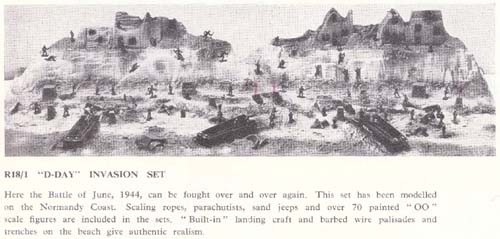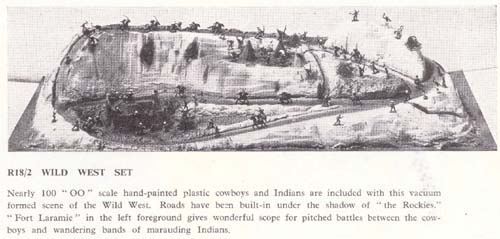
The Lone Star company can trace its origins back to 1939, when its founder, Aubery Robert 'Bob' Mills, began work on his first die casting machine in a lock-up garage in Palmers Green, North London, under the name DCMT Ltd. Ten years later the company had an expanding range of metal toys and decided to produce more cowboy-themed items as 1949 saw the start of a craze in the UK for all things 'Wild West'. To fit with this intended market the company was renamed 'Lone Star'. Business continued to be good and the product range expanded enormously. However the economic troubles of the 1970s took their toll and the company declined, finally going into receivership in 1983.
During its life Lone Star were prolific makers of a huge range of toys, most notably model railways and, of course, the cowboy items such as replica guns. They also produced a wide range of plastic figures, mostly 1/32 scale or larger, using designs purchased from the Harvey company, so they were known as the 'Harvey' series. The only smaller scale figures they ever made were to be found in two playsets, grandly titled 'Harvey Series Giant OO Scale Scenic Sets', and it is these that we are concerned with here.

The first set had as its subject an event that occurred less than 20 years earlier - D-Day. The base, which included most of the apparent accessories such as the landing craft, was vac-formed and "...fixed to [a] sturdy hardboard base" according to the catalogue. The set included over 70 soft plastic figures in 12 poses as shown below - all were scaled down versions of the original 54mm figures.


The first row shows the Germans. Their larger-scale cousins were sold as both Afrikakorps and Stormtroopers (depending on the colour of plastic used), but here they are just generic Germans. They were factory painted, but that only amounted to flesh on the hands and faces, and as can be seen the paintwork was (naturally) done for speed and tended to suffer flaking as the figures were handled. The figures wear a uniform that can't be said to resemble that of 1944 at all, and they are all missing most belts and kit. Strangely they are all wearing a field cap, thus missing the helmet - that most distinctive of items that everyone recognises as German.
The German's foes are British parachutists, which for no apparent reason have been given light blue helmets (their larger cousins were available with helmets in several colours, but all were called British Parachutists). This gives them an initial appearance of UN troops! Once again their uniform has little to do with actual British paratrooper clothing of 1944.
The poses are very flat, and the German running while looking backwards looks very strange, particularly with his right arm at that angle. Of course these were only ever toys, and doubtless no child ever stopped to consider such things. What detail there is is quite well defined, but of course the much simplified uniforms do much to help that. On our examples we found plenty of flash, but no more than might be expected from an Airfix set of the same era.

This set was on a very familiar theme - the American West, as portrayed in so many films of the 50s and 60s. The above picture of the set, like the D-Day set, is taken from the 1965 catalogue, and shows the model set up and ready for play. As can be seen from the original caption, the set includes the Rockies as well as a fort and an Indian camp. Both these sets are pretty large - advertised as 18 inches by 36, which is about 45 by 90cm - but that is still an impressive number of different settings to stimulate the child's imagination.
Most importantly there were almost 100 'OO' scale figures, with six cowboy and seven Indian poses, as shown below.


Again these are all scaled down versions of 54mm models. One cowboy pose (kneeling with pistols) is missing from the picture, as is one indian pose. As with the World War II figures the quality is not great but by no means bad. As so often happens the Indians are mostly chiefs, but the poses in both sets are quite good and lively. The figures were factory painted in many colours, of which these are only a sample.
Plastic Soldier Review would like to express their thanks to the Mill Green Museum, Hatfield for the use of their unique Lone Star archive in the preparation of this article.